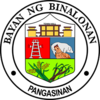Binalonan
[3] One of Binalonan's natives is the Filipino-American writer Carlos Bulosan, who wrote brief descriptions of the town's history and people in his semi-autobiographical novel entitled America is in the Heart.[5] According to historians, the town's name is an evolution of the Pangasinan Language term balon, which means "packed lunch", or in Tagalog, baon.In a traditional story, which now plays an important role in the town's history, the area was originally owned by a Spaniard named Don Salvador.During the course of their work, Don Salvador's men used to have their lunch and rest under Camachile trees located in the center of the land mainly due to its breezy shades.When they asked Don Salcador how they were going to find the said land, the owner answered: "It is the place where people bring their balon to eat".[6] Ilocano herdsmen and laborers composed the first town which was founded in 1838, in San Felipe, which was later transferred to Santa Catalina, then returned to the present site.Roman Catholic, Iglesia Ni Cristo (3 locale chapels at Binalonan Crossing, at San Felipe Central, Sitio Riverside at Brgy.Poverty incidence of Binalonan Source: Philippine Statistics Authority[12][13][14][15][16][17][18][19] Binalonan, belonging to the fifth congressional district of the province of Pangasinan, is governed by a mayor designated as its local chief executive and by a municipal council as its legislative body in accordance with the Local Government Code.The first part of the semi-autobiographical novel features the struggles of Allos, the novel's main character, as he grows up as the son of a peasant farmer in Binalonan.Binalonan Rock Garden defines the town with century-old acacia trees guarding the walking pavements, benches, Balikbayan Hall, basketball court and the pathway towards the historic Santo Niño Parish Church.It was only on January 30, 2008, that the Church's marker was imposed upon generous donations of New York and New Jersey Binalonans (Joey and Remy Castelo-Sellona and Drs.




BinangonanMunicipalityPhilippinesCountryRegionIlocos RegionProvincePangasinan
5th districtFoundedBarangaysSangguniang BayanVice MayorRamon Guico Jr.Municipal CouncilHouseholdsEconomyPoverty incidenceRevenueAssetsExpenditureLiabilitiesTime zoneZIP codearea codeNative languagesIlocanoTagalogCarlos BulosanAmerica is in the HeartEvangelina Guico Macaraeg MacapagalPresidentDiosdado MacapagalGloria Macapagal ArroyoSpaniardCamachileIlocosPozorrubioUrdanetaSan ManuelAsinganLingayenManilapurokssitiosprecipitationPhilippine Statistics AuthorityRoman CatholicIglesia Ni CristoAglipayan Churchfifth congressional districtMunicipal HallDigital CommunicationsRegionschickenssugar caneingredientmuskuvadoacaciaRoman Catholic Archdiocese of Lingayen-DagupanRoman Catholic Diocese of UrdanetaEva MacapagalLeo Soriano (DILG)Local Water Utilities AdministrationWayback MachineSan Carlos CityMunicipalitiesAguilarAlcalaBalungaoBasistaBautistaBayambangBinmaleyBolinaoBugallonBurgosCalasiaoInfantaLabradorMabiniMalasiquiManaoagMangaldanMangataremMapandanNatividadRosalesSan FabianSan JacintoSan NicolasSan QuintinSanta BarbaraSanta MariaSanto TomasUminganUrbiztondoVillasisComponent citiesAlaminosSan CarlosDagupanList of barangays in Pangasinan